
Barnacles are arthropods of the subclass Cirripedia in the subphylum Crustacea. They are related to crabs and lobsters, with similar nauplius larvae. Barnacles are exclusively marine invertebrates; many species live in shallow and tidal waters. Some 2,100 species have been described.

The barnacle goose is a species of goose that belongs to the genus Branta of black geese, which contains species with largely black plumage, distinguishing them from the grey Anser species. Despite its superficial similarity to the brant goose, genetic analysis has shown it is an eastern derivative of the cackling goose lineage.

The little stint is a very small wader. It breeds in arctic Europe and Asia, and is a long-distance migrant, wintering south to Africa and south Asia. It occasionally is a vagrant to North America and to Australia. The genus name is from Ancient Greek kalidris or skalidris, a term used by Aristotle for some grey-coloured waterside birds. The specific minuta is Latin for "small.
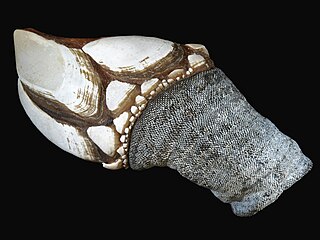
Goose barnacles, also called percebes or turtle-claw barnacles or stalked barnacles or gooseneck barnacles, are filter-feeding crustaceans that live attached to hard surfaces of rocks and flotsam in the ocean intertidal zone. Goose barnacles formerly made up the taxonomic order Pedunculata, but the group has been found to be polyphyletic, with its members scattered across multiple orders of the infraclass Thoracica.

Marchena is a genus of jumping spiders only found in the United States. Its only described species, M. minuta, dwells on the barks of conifers along the west coast, especially California, Washington and Nevada.

Anelasma is a monotypic genus of goose barnacles that live as parasites on various shark hosts.
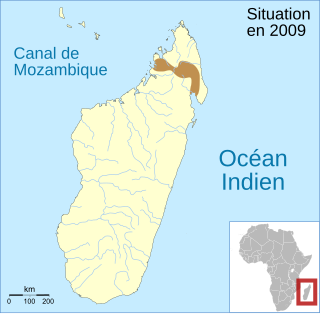
Rhombophryne minuta is a species of frog in the family Microhylidae. It is endemic to northern Madagascar. It has been mixed with other species such as Rhombophryne mangabensis; it is known with certainty only from the Marojejy National Park.

The swamp musk shrew, or musk shrew, is a species of mammal in the family Soricidae. It occurs in Angola, Botswana, Democratic Republic of the Congo, Mozambique, Namibia, South Africa, Eswatini, Zambia and Zimbabwe. Its natural habitat is swamps, and it is a common species in suitable habitats, with the International Union for Conservation of Nature listing it as being of "least concern".

Jasus lalandii, the Cape rock lobster or West Coast rock lobster or South African rock lobster, is a species of spiny lobster found off the coast of Southern Africa. It is not known whom the specific epithet lalandii commemorates, although it may the French naturalist and taxonomer Pierre Antoine Delalande.

Seashore wildlife habitats exist from the Tropics to the Arctic and Antarctic. Seashores and beaches provide varied habitats in different parts of the world, and even within the same beach. Phytoplankton is at the bottom of some food chains, while zooplankton and other organisms eat phytoplankton. Kelp is also autotrophic and at the bottom of many food chains. Coastal areas are stressed through rapid changes, for example due to tides.

Lepas anserifera is a species of goose barnacle or stalked barnacle in the family Lepadidae. It lives attached to floating timber, ships' hulls and various sorts of flotsam.

Lepas anatifera, commonly known as the pelagic gooseneck barnacle or smooth gooseneck barnacle, is a species of barnacle in the family Lepadidae. These barnacles are found, often in large numbers, attached by their flexible stalks to floating timber, the hulls of ships, piers, pilings, seaweed, and various sorts of flotsam.

Pollicipes polymerus, commonly known as the gooseneck barnacle or leaf barnacle, is a species of stalked barnacle. It is found, often in great numbers, on rocky shores on the Pacific coasts of North America.
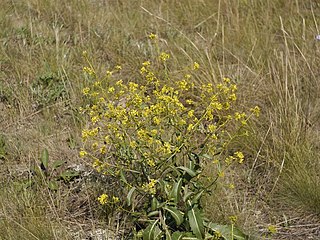
Brassica elongata, the elongated mustard or long-stalked rape, is a species of the mustard plant that is native to parts of Central Europe, Eastern Europe, the Balkan Peninsula, the Caucasus, Morocco and parts of Central Asia. Through plant invasion this species has become naturalized in many other parts of the world. Some of these naturalized regions include South Africa, North Western Europe, Australia and North America. Given the wide range of climate and ecological conditions of these regions, B. elongata has been able to disrupt the ecosystems of their native plant habitats and has been label as an invasive species in many of its naturalized zones. In North America, this species is often found as a roadside weed in the southwestern states, particularly in the state of Nevada. Studies allude that the Cruciferae might have migrated through the Bering land bridge from what is now Central Asia. Commonly known as the long-stalked rape or as langtraubiger Kohl in German, this species is a close cousin to Brassica napus (rapeseed) and a secondary genetic relative to B. oleracea (kale). As a close genetic species of the rapeseed, the long-stalked rape has one of the highest counts of accumulated polyunsaturated linoleic and linolenic acid. Both compounds are heavily used to manufacture vegetable oils. Brassica elongata has the propagative potential of turning into a horticultural product from what is currently a noxious weed.

Megabalanus coccopoma, the titan acorn barnacle, is a tropical species of barnacle first described by Charles Darwin in 1854. Its native range is the Pacific coasts of South and Central America but it is extending its range to other parts of the world.
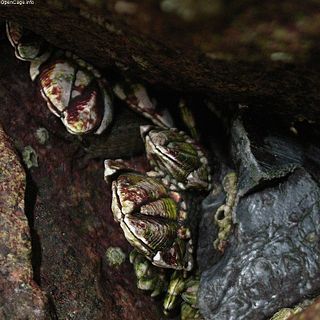
Capitulum is a monotypic genus of sessile marine stalked barnacles. Capitulum mitella is the only species in the genus. It is commonly known as the Japanese goose barnacle or kamenote and is found on rocky shores in the Indo-Pacific region.

Glyptelasma hamatum is a species of goose barnacle in the family Poecilasmatidae.
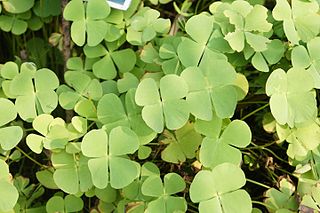
Marsilea minuta, or dwarf waterclover is a species of aquatic fern in the family Marsileaceae. It is not to be confused with Marsilea minutaE.Fourn. 1880, which is a synonym for Marsilea vestita. Other common names include gelid waterklawer, small water clover, airy pepperwort, and pepperwort, though the lattermost also applies to plants in the genus Lepidium. In French it is called marsilea à quatre feuilles and petite marsilée, the latter appearing to be a calque with the Latin botanical name. In Chinese it is 南国田字草, literally "southern field word grass," referencing the similarity of the leaflet shape to the Chinese character for "field." The Koch Rajbongshi people and Garo people call it shusni shak. It is called 'শুশনি শাক' in Bengali. In parts of India it can be called sunisanakka In Indonesian it is semanggi, but this name also applies to Marsilea crenata. In Japanese it is nangokudenjiso and in Thai it is phakwaen. In Malaysian it is tapak itik. In the Philippines it is kaya-kayapuan.

Serruria elongata or long-stalk spiderhead is a plant belonging to the protea family. It is an erect, hairless shrublet of 1–1½ m (3½–5 ft) high with densely set, alternate, finely divided leaves lower down the plant, with needle-like segments. On top of an up to 30 cm (12 in) long inflorescence stalk are several, loosely arranged heads of pin-like, densely silvery-haired flower buds, each of which opens with four curled, magenta pink corolla lobes. The species is endemic to the southern Western Cape province of South Africa. It flowers during the southern hemisphere winter and early spring, between June and September.

Conchoderma virgatum is a species of goose barnacle in the family Lepadidae. It is a pelagic species found in open water in most of the world's oceans attached to drifting objects or marine organisms.




















